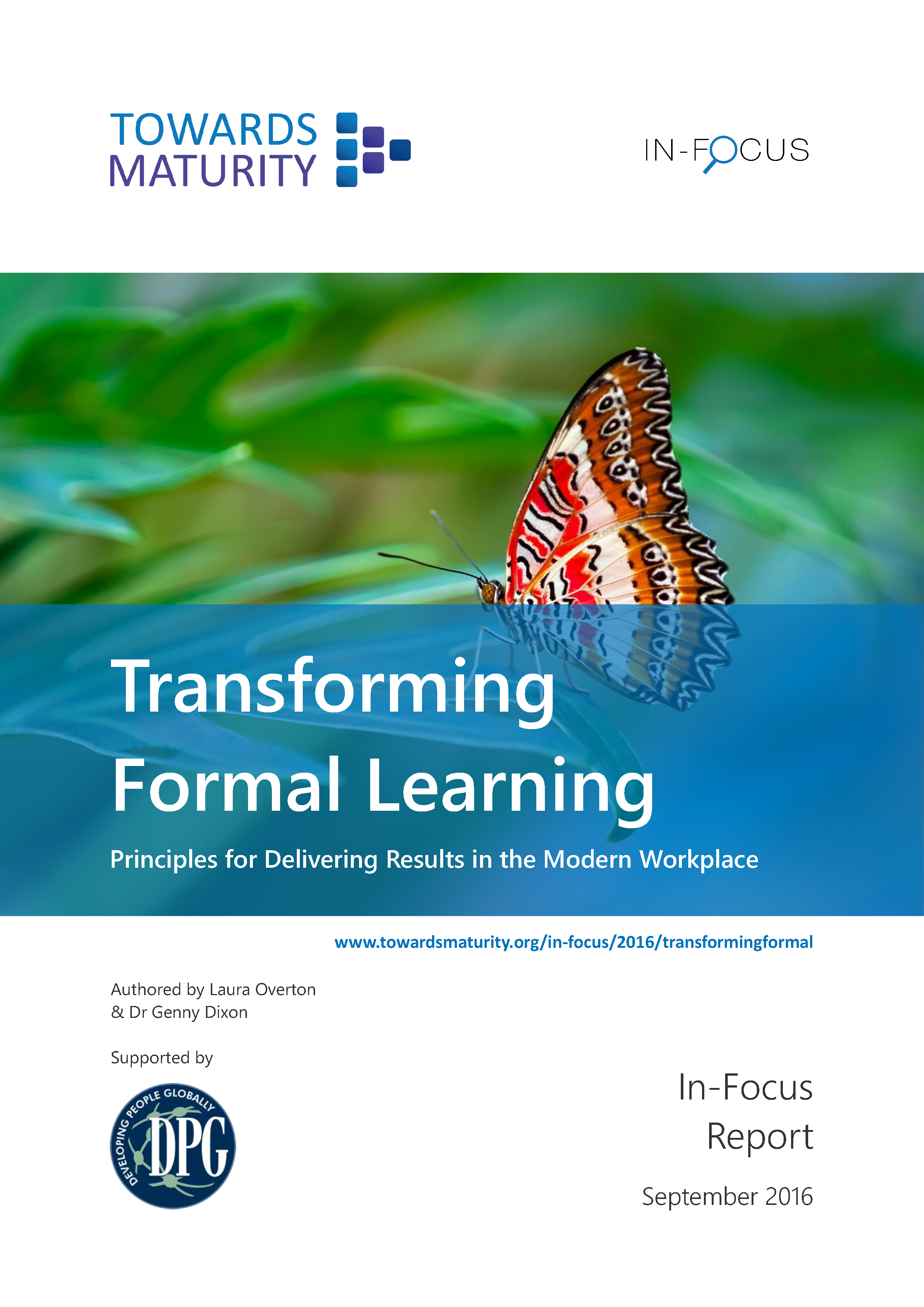
Towards Maturity Report Outlines How Transforming Formal Learning Can Bring Business Results
A new report shows how the potential business return from innovation in the formal learning experience can be achieved by learning from top performing L&D teams.
Adapting formal learning to meet the demands of modern workplaces remains a huge challenge for employers. A new report, released today from Towards Maturity, highlights how these challenges can be overcome to bring business results, looking at what top performing organisations are doing, what motivates people to learn and what those achieving faster application in the workplace are doing.
The report, In-Focus: Transforming Formal Learning, sponsored by DPG, analyses data from over 600 L&D leaders in the Towards Maturity 2015 Benchmark Study™ , along with the Towards Maturity Learning Landscape Study™, on a sample gathered online during 2015 with over 1,600 staff across all sectors and ages. Formal face-to-face learning opportunities are viewed as 'essential or very useful' by 55% of employees, but at the same time, nine-in-ten want to be able to learn at their own pace. With L&D’s focus shifting to more learner-centric approaches, as well as improving business support and business outcomes, nine-in-ten L&D professionals are keen to improve the effectiveness of their face-to-face programmes and this is reflected in the approaches of top learning organisations - those in the top 25% on the Towards Maturity Index.
90% of top learning organisations are integrating technology in order to improve the classroom experience. However, on average, only 33% say they are doing this. Top learning organisations are:
- Almost twice as likely to agree that staff understand how their work is linked to the organisation’s performance
- Three times more likely to support individual career aspirations
- Four times as likely to use diagnostic tools to tailor learning to individual need
Organisations that are successfully transforming their formal learning are four times more likely to blend technology into their learning solutions.
These organisations use a range of approaches to create an engaging learning experience with 80% using video, audio and animation in their online content and 73% including subject matter experts in the design of blended solutions.
Commenting on the findings, Towards Maturity Founder and CEO Laura Overton, said:
“Learners are demanding more from formal learning interventions. Learning technologies can offer new ways to increase the effectiveness of face-to-face learning, blend and personalise programmes to meet individual need and speed up the application of learning into the workplace, leading to faster competence. Face-to-face programmes might not be going anywhere fast, but how they are designed as a part of an overall learning experience is now a key issue that L&D teams need to tackle.”
96% of L&D professionals want to speed up the application of formal learning in the workplace via technology-enabled learning, but only 17% are achieving their goals. However, by examining top performing L&D teams, Towards Maturity have identified a set of activities that can help bring better results in the workplace.
The report suggests five areas where L&D can improve the formal learning experience:
- Set clear outcomes, establish clear personal benefits, define clear pathways and provide support, ensuring that learners are connected with each other
- Provide support systems for staff so they can access learning opportunities and colleagues easily, and are given the time to learn
- Set out the personal benefits, so employees understand how learning programmes can have an impact on their career progression
- Provide clear learning pathways, so employees can find their own way through programmes
- Help employees connect by creating a collaborative learning environment. New staff learn best from their managers and co-workers – learning technologies can help facilitate this connection.
Paul Drew, Managing Director at DPG, commented:
“Despite shouts that formal learning only amounts for 10% of what we learn, formal learning is not dead. It is still critical to creating a sense of engagement and interactivity, but now we use different technologies and approaches. In fact, it’s very much alive and this report will outline all the reasons why.
We’re proud to have joined forces with Towards Maturity and use the benchmark data to highlight how formal learning can be transformed to bring real value and improvements in performance. Our experience of over 25 years in delivering formal programmes, serves to support the notion that designing quality learning experiences still sits at the heart of workplace learning. Our hope is that you enjoy and use the findings in this report.”
The full report is available to download for free at
www.towardsmaturity.org/in-focus/2016/transformingformal.
ENDS
More information
For more information or to request an interview, please email press@towardsmaturity.org or call +44 (0)208 545 2600.
“Top learning organisations” are companies of all sizes and sectors and are defined as those in the top quartile of the Towards Maturity Index. These organisations consistently report that a modernised learning strategy has improved results in terms of customer engagement, business agility, staff engagement and efficiency.
About DPG
We are Developing People Globally (DPG), leading the way with flexible learning solutions that guarantee success in your CIPD qualification. We are here so that you, as an HR or L&D professional, can build your capability, drive the performance of your organisation and fast track your career unlike anyone else.
We are people development experts with over 25 years’ experience of delivering innovative and credible quality programmes with proven results. Our philosophy is simple:
Your success is our success.
Visit www.dpgplc.co.uk for more information.


